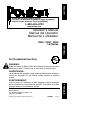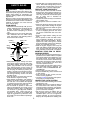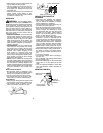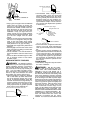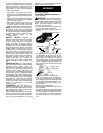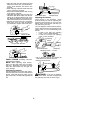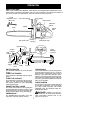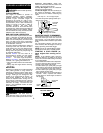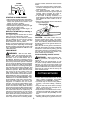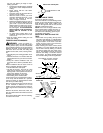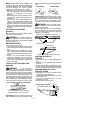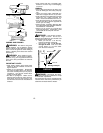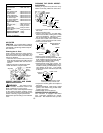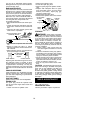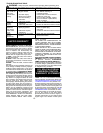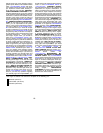
10
ing your saw before you begin a major
sawing operat ion.
S
Squeeze the throttle t rigger and allow
the engine to reach full speed before
cutting.
S
Begin cutting with the saw frame
against the log.
S
Keep the engine at full speed the en-
tire time you are cutting.
S
Allow t he chain to cut for you. Exert
only light downward pressure. If you
force the cut, damage to the bar,
chain, or engine can result.
S
Release the throttle trigger as soon as
the cut is completed, allowing the en-
gine to idle. If you run t he saw at full
throttle without a cutting load, unnec-
essary wear can occur to the chain,
bar,and engine. It is recommended
that the engine not be operated for
longer than 30 seconds at full
throttle.
S
To avoid losing control when cut is
complete, d onot put pressure on saw
at end of cut.
S
Stop the engine before setting the saw
down after cutting.
TREE FELLING TECHNIQUES
WARNING:
Check for broken or
dead branches which can fall while cutting
causing serious injury. Donot cutnear build-
ings or electrical wires if you donot knowthe
direction o ftree fall, norcut atnight sinceyou
will not be ale t o see well, nor during bad
weather such asrain, snow,or strong winds,
etc.
S
Carefully plan your sawingoperation inad-
vance.
S
Clearthe workarea. Youneed acleararea
all around the tree soyoucan have secure
footing.
S
Study the natural conditions that can
cause the tree to fall in a particular direc-
tion.
Natural conditions that can cause a tree to
fall i n a particular direction include:
S
The wind direction and speed.
S
The lean of the tree. The lean of a tree
might not be apparent due to uneven or
sloping terrain. Useaplumb orlevel tode-
termine the direction of tree lean.
S
Weight and branches on one side.
S
Surrounding trees and obstacles.
Look for decay and rot. If the trunk is rotted,
it can snap and fall toward the operator.
Check for broken or dead branches which
can fall on you while cutting.
Make sure there is enough roomfor the tree
to fall. Maintain a distance of
2-1/2
tree
lengths from the nearest person or other ob-
jects. Engine noise can drownout awarning
call.
Remove dirt, stones, loose bark, nails, sta-
ples, and wire fromthe tree wherecuts areto
be made.
Plan a clear retreat path to the rear anddiag-
onal to the line of fall.
Direction of Fall
45
_
Plan a clear retreat path
FELLING LARGE TREES
(6 inches in diameter or larger)
The notch method is used to fell large trees.
Anotch is cuton the sideof thetreein thede-
sired direction of fall. After a felling cut is
made on the opposite side of tree, the tree
will tend to fall into the notch.
NOTE:
If the tree has large buttress roots,
remove them bef ore making the notch. If
using saw to remove buttress roots, keep
saw chain from contacting ground to pre-
vent dulling of the chain.
NOTCH CUT AND FELLING THE
TREE
S
Make notch cut by cutting the top of the
notch first. Cut through
1/3
of the diameter
ofthe tree. Nextcomplete thenotch bycut-
ting the bottom of the notch. See illus-
trated. Once the notch is cut remove the
notch of wood from the tree.
S
After removing the cutout of wood, make
the felling cut on the opposite side of the
notch. This is done by making a cut about
two inches higher than the center of the
notch. This will leave enough uncut wood
between the felling cut and the notch to
form a hinge. This hinge will help prevent
the tree fromf alling in thewrong direction.
Notch
First cut
Second cut
Final (felling) cut here. 2 inches
above center of notch.
Hinge
Opening
of felling
cut
Closing of
notch
Hinge holds tree on stump and helps
control fall



